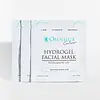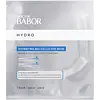What's inside
What's inside
 Key Ingredients
Key Ingredients

 Benefits
Benefits

 Concerns
Concerns

 Ingredients Side-by-side
Ingredients Side-by-side

Water
Skin ConditioningButylene Glycol
HumectantGlycerin
HumectantMethylpropanediol
SolventCarrageenan
1,2-Hexanediol
Skin ConditioningGlucomannan
Skin ConditioningCeratonia Siliqua Gum
EmollientDipropylene Glycol
HumectantAgar
MaskingNiacinamide
SmoothingPEG-60 Hydrogenated Castor Oil
EmulsifyingXanthan Gum
EmulsifyingSodium Hyaluronate
HumectantGlycyrrhiza Glabra Root Extract
BleachingZingiber Officinale Root Extract
MaskingSchisandra Chinensis Fruit Extract
Skin ConditioningCoptis Japonica Root Extract
Skin ConditioningCamellia Sinensis Leaf Extract
AntimicrobialEthylhexylglycerin
Skin ConditioningCaprylic/Capric Triglyceride
MaskingDextrin
AbsorbentSucrose
HumectantPotassium Chloride
Dipotassium Glycyrrhizate
HumectantDisodium EDTA
Citrus Aurantium Bergamia Fruit Oil
MaskingCaprylyl Glycol
EmollientAnthemis Nobilis Flower Extract
MaskingPrunus Serrulata Flower Extract
Skin ConditioningPearl Extract
AntioxidantWater, Butylene Glycol, Glycerin, Methylpropanediol, Carrageenan, 1,2-Hexanediol, Glucomannan, Ceratonia Siliqua Gum, Dipropylene Glycol, Agar, Niacinamide, PEG-60 Hydrogenated Castor Oil, Xanthan Gum, Sodium Hyaluronate, Glycyrrhiza Glabra Root Extract, Zingiber Officinale Root Extract, Schisandra Chinensis Fruit Extract, Coptis Japonica Root Extract, Camellia Sinensis Leaf Extract, Ethylhexylglycerin, Caprylic/Capric Triglyceride, Dextrin, Sucrose, Potassium Chloride, Dipotassium Glycyrrhizate, Disodium EDTA, Citrus Aurantium Bergamia Fruit Oil, Caprylyl Glycol, Anthemis Nobilis Flower Extract, Prunus Serrulata Flower Extract, Pearl Extract
Water
Skin ConditioningGlycerin
HumectantNiacinamide
SmoothingPanthenol
Skin ConditioningCentella Asiatica Extract
CleansingAloe Barbadensis Leaf Extract
EmollientHyaluronic Acid
HumectantSodium Hyaluronate
HumectantSodium Acetylated Hyaluronate
HumectantHydrolyzed Sodium Hyaluronate
Skin ConditioningPotassium Hyaluronate
Skin ConditioningPolyglutamic Acid
Skin ConditioningHamamelis Virginiana Extract
AntiseborrhoeicZanthoxylum Piperitum Fruit Extract
Skin ConditioningCocos Nucifera Fruit Extract
EmollientLonicera Japonica Flower Extract
Skin ConditioningCitrus Paradisi Fruit Extract
Skin ConditioningEpilobium Angustifolium Flower/Leaf/Stem Extract
Skin ConditioningAscophyllum Nodosum Extract
Skin ConditioningSodium Citrate
BufferingCitric Acid
BufferingCaprylyl/Capryl Glucoside
Cleansing1,2-Hexanediol
Skin ConditioningButylene Glycol
HumectantXanthan Gum
EmulsifyingMethylpropanediol
SolventDisodium EDTA
Phenoxyethanol
PreservativeWater, Glycerin, Niacinamide, Panthenol, Centella Asiatica Extract, Aloe Barbadensis Leaf Extract, Hyaluronic Acid, Sodium Hyaluronate, Sodium Acetylated Hyaluronate, Hydrolyzed Sodium Hyaluronate, Potassium Hyaluronate, Polyglutamic Acid, Hamamelis Virginiana Extract, Zanthoxylum Piperitum Fruit Extract, Cocos Nucifera Fruit Extract, Lonicera Japonica Flower Extract, Citrus Paradisi Fruit Extract, Epilobium Angustifolium Flower/Leaf/Stem Extract, Ascophyllum Nodosum Extract, Sodium Citrate, Citric Acid, Caprylyl/Capryl Glucoside, 1,2-Hexanediol, Butylene Glycol, Xanthan Gum, Methylpropanediol, Disodium EDTA, Phenoxyethanol
Ingredients Explained
These ingredients are found in both products.
Ingredients higher up in an ingredient list are typically present in a larger amount.
1,2-Hexanediol is a synthetic liquid and another multi-functional powerhouse.
It is a:
- Humectant, drawing moisture into the skin
- Emollient, helping to soften skin
- Solvent, dispersing and stabilizing formulas
- Preservative booster, enhancing the antimicrobial activity of other preservatives
Butylene Glycol (or BG) is used within cosmetic products for a few different reasons:
Overall, Butylene Glycol is a safe and well-rounded ingredient that works well with other ingredients.
Though this ingredient works well with most skin types, some people with sensitive skin may experience a reaction such as allergic rashes, closed comedones, or itchiness.
Learn more about Butylene GlycolDisodium EDTA plays a role in making products more stable by aiding other preservatives.
It is a chelating agent, meaning it neutralizes metal ions that may be found in a product.
Disodium EDTA is a salt of edetic acid and is found to be safe in cosmetic ingredients.
Learn more about Disodium EDTAGlycerin is already naturally found in your skin. It helps moisturize and protect your skin.
A study from 2016 found glycerin to be more effective as a humectant than AHAs and hyaluronic acid.
As a humectant, it helps the skin stay hydrated by pulling moisture to your skin. The low molecular weight of glycerin allows it to pull moisture into the deeper layers of your skin.
Hydrated skin improves your skin barrier; Your skin barrier helps protect against irritants and bacteria.
Glycerin has also been found to have antimicrobial and antiviral properties. Due to these properties, glycerin is often used in wound and burn treatments.
In cosmetics, glycerin is usually derived from plants such as soybean or palm. However, it can also be sourced from animals, such as tallow or animal fat.
This ingredient is organic, colorless, odorless, and non-toxic.
Glycerin is the name for this ingredient in American English. British English uses Glycerol/Glycerine.
Learn more about GlycerinMethylpropanediol is a synthetic solvent and humectant.
As a solvent, it helps dissolve other ingredients, helping to evenly distribute ingredients throughout the product. This ingredient has also been shown to have antimicrobial properties which makes it a preservative booster.
Methylpropanediol is able to add a bit of moisture to the skin. It also helps other ingredients be better absorbed into the skin, such as salicylic acid.
Learn more about MethylpropanediolNiacinamide is a multitasking form of vitamin B3 that strengthens the skin barrier, reduces pores and dark spots, regulates oil, and improves signs of aging.
And the best part? It's gentle and well-tolerated by most skin types, including sensitive and reactive skin.
You might have heard of "niacin flush", or the reddening of skin that causes itchiness. Niacinamide has not been found to cause this.
In very rare cases, some individuals may not be able to tolerate niacinamide at all or experience an allergic reaction to it.
If you are experiencing flaking, irritation, and dryness with this ingredient, be sure to double check all your products as this ingredient can be found in all categories of skincare.
When incorporating niacinamide into your routine, look out for concentration amounts. Typically, 5% niacinamide provides benefits such as fading dark spots. However, if you have sensitive skin, it is better to begin with a smaller concentration.
When you apply niacinamide to your skin, your body converts it into nicotinamide adenine dinucleotide (NAD). NAD is an essential coenzyme that is already found in your cells as "fuel" and powers countless biological processes.
In your skin, NAD helps repair cell damage, produce new healthy cells, support collagen production, strengthen the skin barrier, and fight environmental stressors (like UV and pollution).
Our natural NAD levels start to decline with age, leading to slower skin repair, visible aging, and a weaker skin barrier. By providing your skin niacinamide, you're recharging your skin's NAD levels. This leads to stronger, healthier, and younger looking skin.
Another name for vitamin B3 is nicotinamide. This vitamin is water-soluble and our bodies don't store it. We obtain Vitamin B3 from either food or skincare. Meat, fish, wheat, yeast, and leafy greens contain vitamin B3.
The type of niacinamide used in skincare is synthetically created.
Learn more about NiacinamideSodium Hyaluronate is hyaluronic acid's salt form. It is commonly derived from the sodium salt of hyaluronic acid.
Like hyaluronic acid, it is great at holding water and acts as a humectant. This makes it a great skin hydrating ingredient.
Sodium Hyaluronate is naturally occurring in our bodies and is mostly found in eye fluid and joints.
These are some other common types of Hyaluronic Acid:
Learn more about Sodium HyaluronateWater. It's the most common cosmetic ingredient of all. You'll usually see it at the top of ingredient lists, meaning that it makes up the largest part of the product.
So why is it so popular? Water most often acts as a solvent - this means that it helps dissolve other ingredients into the formulation.
You'll also recognize water as that liquid we all need to stay alive. If you see this, drink a glass of water. Stay hydrated!
Learn more about WaterXanthan gum is used as a stabilizer and thickener within cosmetic products. It helps give products a sticky, thick feeling - preventing them from being too runny.
On the technical side of things, xanthan gum is a polysaccharide - a combination consisting of multiple sugar molecules bonded together.
Xanthan gum is a pretty common and great ingredient. It is a natural, non-toxic, non-irritating ingredient that is also commonly used in food products.
Learn more about Xanthan Gum